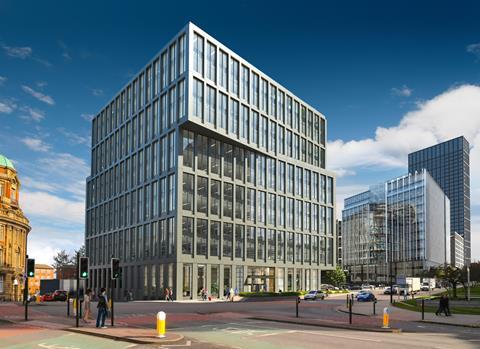Energy regulations in the UK do not deliver buildings that perform as intended. Could the Australian alternative provide a better solution? Thomas Lane reports


Imagine buying a car advertised as doing 50 miles to the gallon but discovering that it only did 13. Most people would assume there was a fault and demand a fix or a refund so they could buy something that performed as described.
Yet we barely blink when the same performance deficiencies are found with buildings. Research carried out by national research and innovation agency Innovate UK in 2016 revealed that on average non-domestic buildings use 3.8 times more energy than predicted at the design stage. Only one out of 49 buildings in the study met the predicted carbon target in use.
Part L was never intended to be a predictive tool, just a way of allowing people to comply with building regulations and have some flexibility in doing so
Alan Fogarty, Cundall
Why is this? There are two main reasons, the carbon emissions calculation methodology in Part L, which regulates energy, and a failure to scrutinse post completion energy performance.
Part L features a relatively simple methodology for predicting carbon emissions at the design stage. It is based on the so-called “notional building”, a hypothetical building of the same size, shape, orientation and end-use as the one being designed. This notional building has predefined characteristics including fabric U values, glazing area and servicing strategy with a carbon dioxide emission rate based on those parameters.
The building designer must equal or beat that rate with their design. This approach does not account for the the sophistication of modern building services design and the only post-completion check is that large buildings must be subjected to an air pressure test to check these meet minimum air infiltration requirements.
There are no fabric thermal performance checks or scutiny of how well the building’s services and controls have been set up. Quite often building services commissioning is rushed because this takes place when the contractor is under pressure to meet the contracted completion date, which means the building starts out in life far less efficient than it could be. And, crucially, building regulations take no account of how the building will be used.
“All Part L does is check efficiency by comparing systems and U values,” says Alan Fogarty, a building services engineer and partner at Cundall. “It doesn’t allow for people working in the evening or at weekends, or higher occupancy densities or anything like that. Part L was never intended to be a predictive tool, just a way of allowing people to comply with building regulations and have some flexibility in doing so.”

Could voluntary environmental rating systems including BREEAM and LEED provide an answer? These award credits for low energy design but are much wider in scope than Part L as a range of environmental impacts including the materials the building is constructed from, water use and waste are also included in the rating.
What about energy performance certificates, which grade how efficient a building is on a scale from A to G and display energy certificates (DEC) which measure actual energy use and are compulsory on all public buildings over 250m2? According to Innovate UK, these are not much help as its research found almost no correlation between a building’s EPC and DEC, and very little relationship between a BREEAM rating and actual energy performance.
The rapid rise of NABERS
The drive for net zero and energy price hikes has given a new impetus to solving the performance gap issue, with a promising solution arriving in the UK from down under. Called NABERS, the National Australian Built Environment Rating System has been used there for over 20 years.
It uses much more sophisticated energy modelling processes than Part L and crucially certification is conditional on annual monitoring after building completion. This has driven big improvements in Australia. According to NABERS, certified offices have benefited from average energy savings of 42%, with carbon emission reductions of 53% over the past 14 years.
NABERS was tweaked for the UK market and introduced here in November 2020 with the first new-build projects designed with it coming up to completion. Administered by BRE and supported by many UK institutions including RICS, RIBA, the UKGBC, CIBSE and developers including British Land, Landsec, Derwent and Lendlease, it rapidly gained traction in the UK.
>>Click here for more on the Building the Future Commission
According to Jim Saywell, a director at Buro Happold, all the commercial buildings the firm is working on are looking to target a NABERS rating. Saywell is an independent design reviewer for NABERS so assesses the buildings that other firms are working on, giving him a comprehensive overview of take-up.
“It’s starting to build momentum now,” he says, adding that the early adopters who marketed their buildings as having a high NABERS rating kickstarted the market. “All their competitors are seeing this is becoming the new standard.”
There is a good business case for NABERS too. Last year, research carried out by real estate consultant JLL found central London office buildings with good sustainability credentials commanded rental premiums of between 6% and 11%, thanks to the shortage of green office buildings. Could NABERS be the answer to tackling the performance gap and, if so, do Part L failings mean its days are numbered?

How NABERS works
NABERS is based on a star rating, where one star is considered poor and six stars is market leading. Many UK developers are targeting a five-star rating. For example, 4 Angel Square on Manchester’s NOMA development, an office that is coming up to completion, is targeting a five-star rating and will be net zero in operation with a BREEAM Outstanding rating and an EPC of A.
Unlike Part L, which uses a notional building for compliance, NABERS relies on a database of real buildings for the ratings benchmarks. Only office buildings can receive NABERS ratings in the UK as there are not building databases for other building types. Australia has benchmarks for a much wider range of building types and, in time, databases for a wider range of buildings could be built up in the UK too.
NABERS is a game of two halves in that it is used first as a design tool then to monitor the building after occupation. A provisional rating is applied once the design has been finalised and assessed, with the final certificate issued after one year’s operational data is available to prove the design works.
Buildings must be 70% occupied. Thereafter operational data is submitted annually to keep the rating, which can go up or down depending on how well the building is managed. This also means owners of existing buildings can apply for a NABERS rating.
Even if you don’t do any of the post occupancy stuff the building will probably perform better than Part L given the fact you have done the modelling more thoroughly and the design has been independently assessed
Jim Saywell, Buro Happold
The NABERS process, which is called “design for performance”, starts by the project team committing to a target rating, which is followed by designing and modelling the building to meet that goal. Modelling is much more sophisticated than that used for Part L.
“Part L uses a relatively straightforward calculation methodology whereas design for performance requires that you do a detailed heating, ventilation and air-conditioning model,” explains Saywell. “The systems are modelled in far more detail, with controls that are representative of the ones that will be used in the actual building.”
The next stage is to subject the design to a sensitivity analysis, which involves applying four exceptional climate or building service scenarios to the model, such as the impact on building performance of extremely hot weather, leaving the lighting on all night or much higher occupancy than anticipated.
The design is then subjected to a review by an independent panel that checks the assumptions made by the engineer against the design to make this is accurate. Neither the sensitivity analysis nor the independent review is required by Part L.
This alone represents a big step forward for Saywell in terms of tackling the performance gap. “Even if you don’t do any of the post-occupancy stuff, the building will probably perform better than Part L given the fact you have done the modelling more thoroughly and the design has been independently assessed.”

A more rigorous approach
According to Peter Fisher, a director at architect Bennetts Associates, the greater accuracy of design for performance modelling offers more design flexibility. The prescriptive nature of Part L, which demands minimal glazing ratios and high U values for building fabric, does not account well for buildings with minimal heating requirements, as high U values are built into the notional building.
Bennetts Associates has designed Timber Square, a large net zero central London office which is the first new-build project aiming for a five-star design review NABERS rating yet features significant amounts of glazing on some elevations – something which is penalised under Part L.
“The building is aiming for a five-star NABERS rating but, under Part L, it only just passes,” Fisher says. “There is a danger the Part L model drives you towards the wrong conclusions as it is so simplistic.”
Fisher adds that the rigorous design for performance model approach creates more efficient design solutions. “There is a tendency with engineers to throw more peak capacity at something on the grounds this will always be OK,” he says.
“At Timber Square, on the first round of NABERS, we found the air source heat pumps would be operating at 20% of capacity at peak, whereas these should be operating closer to 60% [for maximum efficiency]. We were able to remove some of the air source heat pumps because they were never going to be used.”
The post-occupancy certification takes account of the energy use of different occupiers in a building and splits this out from landlord energy use. The certification takes account of tenants who work extended hours and use more energy as a result. It also accounts for the building location and the occupation density.
One of the great benefits of accurate energy modelling combined with post-occupancy certification is the process picks up on building faults that could otherwise go unnoticed. This could include systems not being set up properly or the heating and cooling being on simultaneously.
“At least now, with a NABERS rating, it throws up that something is wrong which unleashes an investigation into why the performance is so much worse than predicted,” says Fisher.
The post-occupancy assessments mean more attention needs to be focused on how the building will be used at the design stage. Saywell says NABERS demands that project teams and occupiers work together to ensure the tenant fitout does not compromise the rating. Speculative offices present a bigger challenge because the end user is nt necessarily known until the building is finished.
Building services run more efficiently at full load, which could be an issue in a building where the systems need to be kept going for a tenant occupying part of a building outside normal hours. This means the big central systems are kept running at part-load.
Saywell, who worked on 4 Angel Square, says future buildings at NOMA will be designed using modular systems where several small building services elements are connected together and can be operated independently or together, so the building systems remain efficient for a range of different load scenarios.
The design for performance process is much more involved than Part L modelling, which adds cost as Fisher concedes. “Yes, it is more expensive because in a sense you are doing the job properly. If it has a commercial advantage, then it is definitely worth doing.”
He adds that the design for performance optimisation process reduced the number of air source heat pumps at Timber Square, which saved money. And building occupiers will save money on their energy bills and there is the rental premium commanded by green office buildings to be considered.

Contract obligations and performance guarantees
Could poor build quality negatively affect energy performance once the building is occupied? According to Fogarty, there is talk about contractually obliging contractors to achieving NABERS ratings. He says contractors are nervous about this prospect but still want to be involved.
The key to successful delivery is collaboration. “The main contractor can’t be beating up the M&E subcontractor, they need to work together,” he says. “The experience from Australia shows that, when you get that collaboration and co-operation, you get lower energy consumption because nobody is trying to hide things. If something is wrong, you work together to try and fix it.”
The industry, he adds, will get better at delivering buildings that perform as intended to the point where it becomes standard practice.
Saywell agrees that the industry needs to get to a point where project teams sign up to energy performance guarantees. He cautions that there could be issues with design and build contracts on speculative office projects outside London.
For this market, tenders are generally prepared from RIBA stage 3 information which is not sufficiently detailed for a design reviewer to sign it off, particularly as the contractor is responsible for the detailed design after the contract is signed. “The best thing you can do is get a reviewer to review the stage 3 design and come up with a list of comments,” he says.
“The client team can come up with a response of how the contractor needs to approach it in in detail design. That will give the contractor a little bit less risk when signing up to a target rating.”
Saywell adds that it would be better for contractors to bid on more complete stage 4 information, but the downside is this prolongs the programme as the design and early construction work cannot be done in parallel.
What about the future of Part L?
Given the proven benefits of NABERS, and the enthusiasm of the developer community to embrace it, could it replace Part L? Saywell is a big fan of NABERS but concedes the Part L process has its merits.
“NABERS is a far more robust process and more reflective of reality. It makes the design team focus on actual operational energy as opposed to some kind of theoretical model,” he says. “However, the Part L model is simple so pretty much every organisation can use it and there is a standardised baseline to follow.”
Saywell points out that Part L is used as a baseline by many local planners to set lower energy standards for new buildings, for example the London Plan requires a 35% uplift over Part L with BREEAM ratings working in a similar way. This could be an issue for NABERS, where the certification is only issued after a year of energy monitoring which is beyond the remit of planners. A possible solution would be to align energy performance uplifts required by planners with the target NABERS rating.
>> See also: The proposed Future Buildings Standard in detail
>> See also: How Scottish schools are tackling the energy performance gap
A big barrier to replacing Part L with NABERS is that the latter is currently only applicable to office buildings in the UK. It could take years to build up databases for all building types. And it might be unnecessary for some building types.
Fogarty says schools benefiting from Department for Education (DfE) funding already have an equivalent design and monitoring process. Schools must meet DfE targets, a process which is now being enforced contractually.
“The schools that are being built now will go through exactly the same process [as NABERS] in principle. Predictive modelling is done to check the design works and afterwards energy consumption is monitored to see whether the building is hitting the DfE targets.”
Fogarty reckons there is no point in using NABERS for homes as the Passivhaus standard could do a similar job. Passivhaus uses a rigorous energy modelling process and photographic evidence of workmanship quality must be produced too. This standard produces buildings that are widely recognised as performing as predicted.
The Scottish government recently announced that it intends to mandate Passivhaus standards for new homes north of the border.
Like Saywell, Fogarty cautions against getting rid of Part L because it has the benefit of applying to all buildings, for example private schools are not subject to DfE targets. He points out that Part L standards were tightened last year and will be revised again in 2025, when it will require new buildings to be virtually net zero carbon.
The days of Part L are not numbered; rather, this is likely to be supplemented by NABERS and other standards because these have been proven to deliver buildings that really do what they say on the tin.
He says there is no reason why Part L and NABERS, or indeed other standards, cannot be run in parallel. “It makes sure one of the regulations is checked for every building regardless of what the aspiration of a client is, as they still have to hit that stringent regulation standard,” he says. “For many years, buildings have been built to minimum standards, so I would be very reluctant to remove that [Part L] as you don’t know what you will end up with.”
Double standards may arrive sooner than many expect. In 2021 the Department for Business, Energy & Industrial Strategy (BEIS) published a consultation paper proposing the introduction of a NABERS-type scheme for buildings over 1,000m2. This is because buildings of this size generate over 53% of carbon emissions in England and Wales despite their relatively small numbers.
EPC certification has not helped to reduce these emissions, as the consultation acknowledges there is virtually no correlation between the EPC rating and how much energy buildings use in practice.
The government says it plans to introduce the requirement in three phases during the 2020s, starting with office buildings. So, the days of Part L are not numbered; rather, this is likely to be supplemented by NABERS and other standards because these have been proven to deliver buildings that really do what they say on the tin.
Building the Future Commission

Coming up on the Building the Future commission:
In the coming weeks we will:
- Host our first regional roundtable with our partner Constructing Excellence in the East of England region in mid March
- Convene our first commissioner panel meeting at the end of March
- Investigate the potential of building performance rating system NABERS as an alternative to Part L for the energy and net zero stream
- Interview two big hitters in the world of infrastructure for the infrastructure stream
- Examine whether the qualifications landscape needs to change and assess whether more flexibility is needed for our education and skills stream
- Visit the University of Salford to assess the eHome2 concept for our energy and net zero stream
- Investigate how for-profit affordable housing can deliver the homes we need for the housing and planning stream
- Assess a new model of procurement used by the Ministry of Defence for the project delivery and digital stream
- Look at models of flexible working in the industry for the workplace, culture and leadership stream
About the commission
The Building the Future Commission is a year-long project, launched to mark Building’s 180th anniversary, to assess potential solutions and radical new ways of thinking to improve the built environment.
The major project’s work will be guided by a panel of 19 major figures who have signed up to help guide the commission’s work culminatuing culminate in a report published at the end of the year.
The commissioner include figures from the world of contracting, housing development, architecture, policy-making, skills, design, place-making, infrastructure, consultancy and legal.
The commissioners include Lord Kerslake, former head of the civil service, Katy Dowding, executive vice president at Skanska, Richard Steer, chair of Gleeds, Lara Oyedele, president of the Chartered Institute of Housing, Mark Wild, former boss of Crossrail and chief executive of SGN and Simon Tolson, senior partner at Fenwick Elliott. See the full list here.
The project is looking at proposals for change in eight areas:
- Education and skills
- Housing and planning
- Infrastructure
- Building safety
- Project delivery and digital
- Workplace culture and leadership
- Creating communities
>> Editor’s view: And now for something completely positive - our Building the Future Commission
>> Click here for more about the project and the commissioners
Building the Future will also undertake a countrywide tour of roundtable discussions with experts around the regions as part of a consultation programme in partnership with the regional arms of industry body Constructing Excellence. It will also set up a young person’s advisory panel.
We will also be setting up an ideas hub and we want to hear your views.
>> Email buildingfuturecommission@building.co.uk to get in touch



























No comments yet